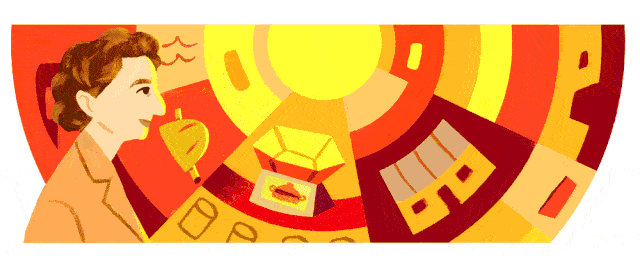
Fascinating and Entertaining Trivia about Mária Telkes, the Groundbreaking “Sun Queen” of Solar Energy
Renowned search engine giant Google pays tribute to Mária Telkes, the esteemed Hungarian-American biophysicist, scientist, and inventor known as the “Sun Queen” for her groundbreaking work in solar energy. On December 12, 2022, Google celebrated her achievements with an engaging animated Google Doodle. Here are some captivating and delightful facts about Mária Telkes.
Mária Telkes, who was born in Hungary in 1900 and passed away in 1995, gained recognition as a distinguished scientist and earned her well-deserved nickname, the “Sun Queen,” due to her remarkable contributions to solar energy research.
Telkes is widely regarded as one of the early pioneers in the practical application of solar energy. Her pioneering work in the field significantly advanced the study and utilization of solar power.
Personal Information about Mária Telkes
Birth date: 12 December 1900
Birthplace: Budapest, Austria-Hungary
Died on: 2 December 1995 (aged 94)
Death place: Budapest, Hungary
Father name: Aladar Telkes
Mother name: Maria Laban de Telkes
Known for: Thermoelectricity
Awards: National Inventors Hall of Fame
22 Interesting Facts about Mária Telkes
- Mária Telkes, born on December 12, 1900, in Budapest, Hungary, to Aladar and Maria Laban de Telkes, began her educational journey in her hometown. She obtained her B.A. in 1920 and her Ph.D. in physical chemistry in 1924 from Budapest University, specializing in the field of physical chemistry.
- In 1925, Mária Telkes visited the United States to meet her relative, the Hungarian consul in Cleveland, Ohio. During her visit, she was offered a position as a biophysicist at the Cleveland Clinic Foundation. Intrigued by the study of energy production in living organisms, she accepted the job and worked there for twelve years under the guidance of scientist George Crile.
- Telkes and Crile collaborated on writing the book “Phenomenon of Life,” which documented their research findings. They also invented a photoelectric mechanism capable of recording brain waves. Telkes further explored the origins of energy, its transformation during cell life and death, and the changes in energy as normal cells turn cancerous.
- In 1937, Mária Telkes became an American citizen and began working as a research engineer at Westinghouse Electric. Over the next two years, she led research and secured patents for innovative thermoelectric devices that converted heat energy into electrical energy.
- Fascinated by solar energy since her high school years, Telkes joined the Massachusetts Institute of Technology Solar Energy Conversion Project in 1939. There, she focused on research related to thermoelectric conversion devices powered by solar heat.
- During her time at MIT, Telkes developed a method for storing solar energy using sodium sulfate. Her research in solar energy began in 1939, establishing her as a pioneer in solar thermal storage systems, earning her the title “The Sun Queen.” Following World War II, she attained the position of associate research professor at MIT.
- Telkes’s expertise led to her appointment as a civilian advisor for the Office of Scientific Research and Development (OSRD) during World War II. She created a solar still that utilized the sun’s heat to evaporate saltwater, providing life-saving drinking water for numerous sailors and airmen stranded at sea. This compact still was suitable for life rafts. Additionally, larger versions of the still were implemented in locations like the Virgin Islands to address water scarcity. In 1945, Telkes received the OSRD Certificate of Merit for her invention.
- In 1948, Telkes researched and designed a pioneering solar heating system installed in a solar house on Amelia Peabody’s estate in Dover, Massachusetts. The house’s architectural design was contributed by Eleanor Raymond, an accomplished architect.
- Telkes received the Society of Women Engineers Achievement Award in 1952, being the first recipient. In 1964, she spoke at the inaugural International Conference of Women Engineers and Scientists in New York.
- In 1953, Telkes relocated to the College of Engineering at New York University, where she established a solar laboratory. Her work continued to focus on developing solar ovens, heating systems, and solar stills. These solar ovens were affordable, simple to construct, and benefited underprivileged communities.
- In 1954, Telkes secured a $45,000 grant from the Ford Foundation to further enhance her solar ovens. She investigated air conditioning systems capable of storing nighttime coolness for use during the day.
- As the head of the solar energy laboratory at the MELPAR Company in 1963, Telkes explored methods of obtaining fresh water from seawater.
- In 1969, Telkes joined the Institute of Energy Conversion at the University of Delaware. Her research involved developing materials for solar energy storage and more efficient heat transfer devices.
- She obtained patents for solar heat storage and played a role in constructing Solar One.
- Mária Telkes also made significant contributions to the development of air conditioning systems that utilized stored nighttime coolness for daytime use.
- In 1977, Mária Telkes received recognition from the National Academy of Science Building Research Advisory Board for her groundbreaking work in solar-heated buildings. She was also honored with the Charles Greeley Abbot Award from the American Solar Energy Society, joining the ranks of renowned innovators like Frank Lloyd Wright and Buckminster Fuller.
- Upon her retirement from active research in 1978, Mária Telkes was granted the title of professor emeritus at the University of Delaware. She continued to work as a consultant until approximately 1992.
- In collaboration with the U.S. Department of Energy, Dr. Mária Telkes played a pivotal role in the construction of the world’s first solar-electric residence in Carlisle, Massachusetts, in 1980.
- Tragically, on December 2, 1995, while returning to her hometown of Budapest, Hungary, for the first time in 70 years, Dr. Mária Telkes passed away.
- Throughout her career, Mária Telkes was a prolific inventor of practical thermal devices. One notable example was a small desalination unit, known as a solar still, designed for lifeboats. By harnessing solar power and condensation, the still provided drinkable water, thereby saving the lives of airmen and sailors who would have otherwise been without water if stranded at sea.
- Over the course of her remarkable journey, Mária Telkes obtained more than 20 patents, including one for a functional solar oven, and continued to advance the field of solar-energy-based applications.
- On December 12, 2022, Google paid tribute to Mária Telkes with an animated Google Doodle on its homepage, celebrating her pioneering achievements. It was on this day in 1952 that Dr. Telkes became the first recipient of The Society of Women Engineers Achievement Award.



